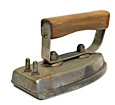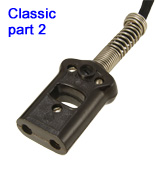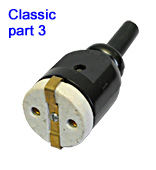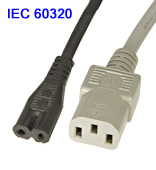 |
Appliance connectors overview |
 |
At first electricity in homes was used for illumination, but already in the 1890s other applications were developed and produced in small series. For example electrical irons, kettles, coffeemakers, toasters, radiators and fans. Handmade plugs were used to connect small heating appliances as irons, kettles and toasters. Plugs and cords were expensive and the idea of using one connecting cord for several appliances was obvious. Most motor-driven appliances had permanently fixed cords. Plugs could become loose due to vibrations. Initially manufacturers of electrical equipment designed their own plug system to connect a flex cable; round pins were commonly used. Flat pin designs were uncommon. |
| Advertisement by the Dutch company
Inventum to promote electrical
appliances that serve to make breakfast (ontbijt) easier (1918). Photograph courtesy of Inventum, Veenendaal. Right: electric flat iron; Swiss made by Therma. Another early application of electricity at home. |
 |
Because diameter and spacing of pins
varied, a diversity of flex cable
connectors were developed, either by the manufacturer of the
equipment, or by independent developers. In Germany, standardization became effective in the 1920s (see classic part 1 page for details). The introduction of a separate earth connection improved the level of safety. |
 |
 |
 |
The museum has a collection of classic
appliance connectors. They are shown on three pages. Part 1: connectors made of porcelain and steatite, mainly of Germany origin. Part 2: connectors of Bakelite, mainly of German origin. Part 3: Connectors made in other European countries, U.S., Australia and elsewhere. |
 |
From
the 1960s fixed flex cords,
including earthing, became the standard method to power most kitchen
appliances, irons, and vacuum cleaners. Nowadays (2010s)
kettles have fully sealed power
connections. Cords with moulded wall plugs and appliance connectors are still used for a wide range of applications in offices and workshops. In 1994 the International Electrotechnical Commission has developed the IEC 60320 standard that is now widely used for power cords. |
 |
 |
Most IEC 60320 do not offer the
possibility to lock a connector. Neutik
has developed a very different type of connector that is provided with
a safe locking system. They are often used for equipment used on stages. Other connectors for portable audio and lighting equipment have been made by Bulgin and Belling Lee. The museum has examples of various classic models. |
| Note on dating of plugs |
Most
plugs shown on the following pages had been made for many years or
decades. Given dates refer either to year or decade in which production
started, or the full period of production. Dates are based on: (i) old catalogs of manufacturers or shops that sold or imported electrotechnical devices, or (ii) estimates based on technical and formal appearances of a plug. |